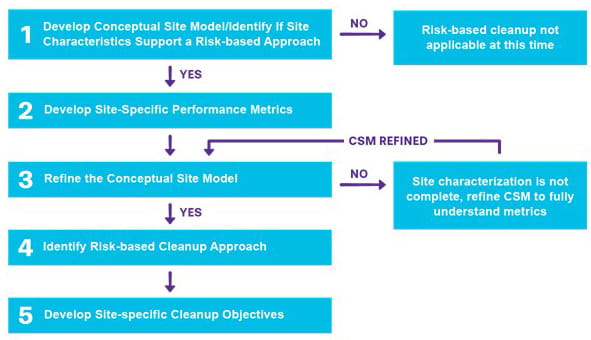Communicating Contamination
Stakeholder engagement often hinges upon the success of one thing: communication. And in the case of environmental remediation, good communication is indispensable. Complex remedial clean-ups can be costly and last for years. Project managers often recoil at the thought of presenting topics like contamination and potential health effects to the general public. “They’re concerned that the public is going to raise an issue that they can’t address, or that they’ll have to expand their scope,” says Dr. Melissa Harclerode, an environmental sustainability scientist and expert in stakeholder engagement at CDM Smith. Fortunately there is a proven way to talk with stakeholders about sensitive topics like contamination, and it’s called risk communication.
Risk communication is the process of informing stakeholders about health or environmental risks, risk assessment results, and proposed risk management strategies. A successfully executed risk communication plan streamlines projects, enhances transparency and alleviates stakeholder concerns.
Just because we're providing the information doesn't mean it's widely understood.
Communicating the complexities of site remediation to lay audiences presents a host of challenges. In the case of emerging contaminants, the experts are still trying to determine the mechanisms behind fate and transport, solidify the scope of toxicity, and categorize thousands of compounds that fall under larger umbrellas like Per- and Polyfluoroalkyl Substances (PFAS). With little context in which to place the threat of contamination, it’s nearly impossible for them to individually assess their own risk.
By focusing on a fully developed risk management plan, environmental scientists and engineers can work together with stakeholders to arrive at a shared understanding of how remediation is performed and the subsequent community benefits. Known as "secondary performance metrics," some benefits of remediation include: source control/removal; reduction in contaminant bioavailability/loading; and the mitigation of exposure pathways.
Below is a look at risk communication organized according to three primary dimensions:
Heighten Understanding
Heighten Understanding
Help the community achieve an understanding of the situation and all uncertainties surrounding the remediation process.
Even in cases with no clear solution or end in sight, informing stakeholders of the health and environmental risks can increase their sense of agency and build trust. It’s also a good time to inform them of the work being done to mitigate, if not solve, the problem. Fact sheets can help increase understanding, especially when paired with strategic community outreach. Of course, understanding is a two-way street. By meeting with stakeholders, you can pinpoint the social factors that act as drivers and barriers to participation and identify the vulnerable populations affected by the contamination.

And don't hesitate to reach out to other local institutions, like universities. Academic institutions make great partners and can help gain access to important stakeholders. For an example, take a look at Bennington College where faculty and other experts have built a course for water purveyors, public works employees, and public health professionals called "Understanding PFOA."
Sharpen Perception
Guide them to a scientifically valid perception of the hazards.
"There are a lot of different factors that go into how someone perceives their risk to a particular hazard," Harclerode says. Some people may shrug off the risk, citing other immediate threats, while the fear of the unknown may heighten perceived risk in others. Surveys are useful tools to assess this dimension. You can measure risk perception along a continuum ranging from attenuation (when experts judge a hazard as serious, but the public does not) to amplification (a stakeholder's heightened sense of risk due to factors like physical traits, demographics, sense of trustworthiness with authorities, and an internal sense of agency).
In 2009, Harclerode and her colleagues decided to study risk perception in Jersey City, New Jersey, where local health experts had been trying to understand why some residents ignored warnings about lead-based paint. Despite the launch of a lead-prevention mitigation program spearheaded by the Jersey City Department of Health, the city still struggled with high lead blood levels.
Using data obtained from about 250 survey respondents, Harclerode and her team discovered common perception factors that affected participation in the mitigation of lead-based paint within residential structures. These factors included participation in household paint and/or blood testing, their proximity to lead-impacted properties, the presence of vulnerable populations (i.e., children under the age of three), and their increased perception of risk to other hazards like water and air pollution. Obtaining a comprehensive understanding of site-specific public perception resulted in a series of recommendations to refine the public outreach strategy and overcome inaction.
Harclerode and her team published their findings in the Journal of Environmental Management. In the same issue, they also introduce the "Early Decision Framework" that leads project managers toward a risk-based remediation approach, when appropriate:

Encourage Participation
Allow stakeholders to participate in decisions about how risk should be managed.
A proper outreach plan includes several preliminary steps prior to a town-hall style gathering. Build engagement gradually by teaming with professionals in academia and the public sector to create a comprehensive community involvement plan. Preliminary steps may include:
- Notifications to the affected population
- Coordination with relevant community groups
- Establishment of community-specific engagement goals
- Press release and briefing
- Community meeting rehearsal
A complete community outreach plan also includes a strategy for reaching underrepresented populations like non-native speakers and low-income families, as well as sensitive populations like children and the elderly. Plan carefully and listen to the public’s concerns. Understand demographic and socio-cultural factors and speak clearly, compassionately, and in nontechnical terms.
By constructing and following a risk communication plan, you can shrink the distance between you and your stakeholders. Engaging with stakeholders shouldn't feel like a burden—think of it as adding another insightful member to your project team.






